 SPARC: To Install or Upgrade With the
Solaris Installation Program
SPARC: To Install or Upgrade With the
Solaris Installation Program
This procedure describes how to install a standalone SPARC based system from CD or DVD media.
Note –
If you want to install the Solaris OS on a machine or domain that does not have a directly attached DVD-ROM or CD-ROM drive, you can use a DVD-ROM or CD-ROM drive that is attached to another machine. For detailed instructions, refer to Appendix B, Installing or Upgrading Remotely (Tasks), in Solaris 10 11/06 Installation Guide: Network-Based Installations.
Before You Begin
Perform the following tasks before you begin your installation.
-
Ensure that you have the following media.
-
Verify that your system meets the minimum requirements.
Your system should meet the following requirements.
-
Memory – 128 Mbytes or greater
-
Disk space – 6.8 Gbytes or greater
-
Processor speed – 200 MHz or greater
For detailed information about system requirements, see System Requirements and Recommendations.
-
-
Gather the information you need to install the Solaris OS.
-
For a nonnetworked system, gather the following information.
-
Host name of the system that you are installing
-
Language and locales that you intend to use on the system
-
-
For a networked system, gather the following information.
Note –Starting with the Solaris 10 11/06 release, you have the option during an initial installation to change the network security settings so that all network services, except Secure Shell, are disabled or restricted to respond to local requests only. This security option is only available during an initial installation, not during an upgrade. An upgrade maintains any previously set services. If necessary, you can restrict network services after an upgrade by using the netservices command. See Planning Network Security in Solaris 10 11/06 Installation Guide: Planning for Installation and Upgrade.
The network services can be enabled after installation by using the netservices open or by enabling individual services by using SMF commands. See Revising Security Settings After Installation in Solaris 10 11/06 Installation Guide: Planning for Installation and Upgrade.
-
Host name of the system that you are installing
-
Keyboard layout
Note –If the keyboard is self-identifying, the keyboard layout automatically configures during installation. If the keyboard is not self-identifying, you can select from a list of supported keyboard layouts during installation.
PS/2 keyboards are not self-identifying. You will be asked to select the keyboard layout during the installation.
For further information, see keyboard Keyword.
-
Language and locales that you intend to use on the system
-
Host IP address
-
Subnet mask
-
Type of naming service (for example, DNS, NIS, or NIS+)
-
Domain name
Note –During installation, you can choose the default NFSv4 domain name. Or, you can specify a custom NFSv4 domain name. For further information, see NFSv4 Domain Name Configurable During Installation.
-
Host name of the name server
-
Host IP address of the name server
-
Root password
-
For information that you need to gather to install your system, see Checklist for Installation. If you are upgrading your system, see Checklist for Upgrading in Solaris 10 11/06 Installation Guide: Planning for Installation and Upgrade.
Note –If you have a system that contains non-global zones, Solaris Live Upgrade is the recommended upgrade program or program to add patches. Other upgrade programs might require extensive upgrade time, because the time required to complete the upgrade increases linearly with the number of installed non-global zones.
For information about upgrading with Solaris Live Upgrade, see Part I, Upgrading With Solaris Live Upgrade, in Solaris 10 11/06 Installation Guide: Solaris Live Upgrade and Upgrade Planning.
-
-
(Optional) Back up your system.
If you want to preserve any existing data or applications, back up the system. For detailed instructions about how to back up your system, see Chapter 23, Backing Up and Restoring File Systems (Overview), in System Administration Guide: Devices and File Systems.
-
Insert the Solaris Operating System for SPARC Platforms DVD or Solaris Software for SPARC Platforms - 1 CD.
-
-
If the system is new, out-of-the-box, turn on the system.
-
If you want to install a system that is currently running, shut down the system.
The ok prompt is displayed.
-
-
Start the Solaris installation program.
-
To boot from the local DVD or CD and start the Solaris installation GUI in a desktop session, type the following command.
ok boot cdrom
-
To boot from the local DVD or CD and start the text installer in a desktop session, type the following command.
ok boot cdrom - text
- text
-
Specifies to run the text installer in a desktop session. Use this option to override the default GUI installer.
-
To boot from the local DVD or CD and start the text installer in a console session, type the following command.
ok boot cdrom - nowin
- nowin
-
Specifies to run the text installer in a console session. Use this option to override the default GUI installer.
For detailed information about the Solaris installation GUI and text installer, see Solaris Installation Program GUI or Text Installer Requirements.
If the operating system cannot locate a self-identifying keyboard, the next screen displays keyboard layout selections.
Note –PS/2 keyboards are not self-identifying. You will be asked to select the keyboard layout during the installation.
-
-
(Optional) Select the desired keyboard layout from the screen below and press F2 to continue.
Configure Keyboard Layout +---------------------------------------------------------------------------+ | Please specify the keyboard layout from the list below. | | | | To make a selection, use the arrow keys to highlight the option and | | press Return to mark it [X]. | | | | Keyboard Layout | | ----------------------- | | [ ] Serbia-And Montenegro | | [ ] Slovenian | | [ ] Slovakian | | [ ] Spanish | | [ ] Swedish | | [ ] Swiss-French | | [ ] Swiss-German | | [ ] Taiwanese | | [ ] TurkishQ | | [ ] TurkishF | | [ ] UK-English | | [ X] US-English | | | | F2_Continue F6_Help | +---------------------------------------------------------------------------+
The system configures the devices and interfaces and searches for configuration files. If you selected a GUI installation in the earlier steps, the next two screens confirm GUI functioning.
-
(Optional) In the following screen, press Enter.
Starting Solaris Interactive (graphical user interface) Installation +------------------------------------------------------------+ | You must respond to the first question within 30 seconds | | or the installer proceeds in a non-window environment | | (console mode). | | | | If the screen becomes blank or unreadable the installer | | proceeds in console mode. | | | | If the screen does not properly revert to console mode, | | restart the installation and make the following selection: | | | | Solaris Interactive Text (Console session) | -------------------------------------------------------------+
Note –If your system has insufficient memory to display a graphical user interface (GUI), the program exists and displays an error message. You can upgrade your memory and restart the installation.
For an alternative that requires less memory to install, restart the installation and select a text installer option instead of the GUI installer option.
After progress messages are completed, another confirmation screen is displayed.
-
(Optional) Move your cursor into the following text screen and press Enter.
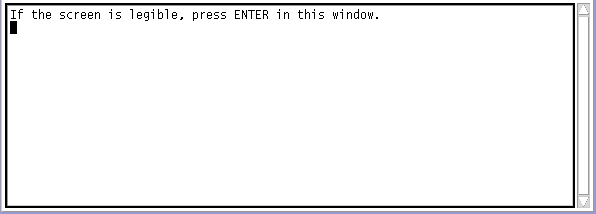
A list of language choices is displayed.
-
In the following screen, select the language you want to use during the installation, and press Enter.

After a few seconds, the Solaris Installation Program Welcome screen appears.
-
If you are running the Solaris GUI installation program, the screen that is shown in Figure 2–1 is displayed.
-
If you are running the Solaris text installer in a desktop session, the screen that is shown in Figure 2–2 is displayed.
Figure 2–1 Solaris GUI Installation Program Welcome Screen
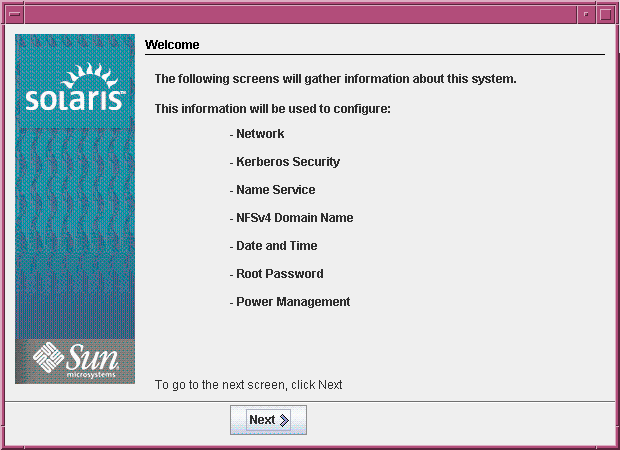
Figure 2–2 Solaris Text Installer Welcome Screen
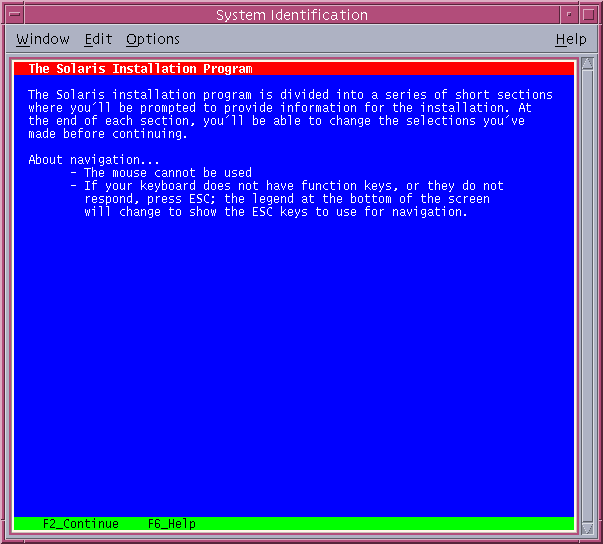
-
-
Click Next to begin the installation. If you are prompted, answer the system configuration questions.
-
If you preconfigured all of the system information, the installation program does not prompt you to enter any configuration information. See Chapter 2, Preconfiguring System Configuration Information (Tasks), in Solaris 10 11/06 Installation Guide: Network-Based Installations for more information.
-
If you did not preconfigure all the system information, the installation program prompts you for this information on several screens. Use the Checklist for Installation to help you answer the configuration questions.
-
During installation, you can choose the default NFSv4 domain name. Or, you can specify a custom NFSv4 domain name. For more information about specifying a domain name, see NFSv4 Domain Name Configurable During Installation.
-
One configuration question asks you whether you want to enable network services for use by remote clients. The default response is “Yes, I would like to enable network services for use by remote clients.”
Selecting “No” provides a more secure configuration in which Secure Shell is the only network service provided to remote clients. Selecting “Yes” enables a larger set of services as in previous Solaris releases. You can safely select “No” as any services can be enabled after installation. For further information about these options, see Planning Network Security in Solaris 10 11/06 Installation Guide: Planning for Installation and Upgrade.
The network services can be enabled after installation by using the netservices open command or by enabling individual services by using SMF commands. See Revising Security Settings After Installation in Solaris 10 11/06 Installation Guide: Planning for Installation and Upgrade.
After you answer the configuration questions, the Welcome to Solaris screen appears.
Figure 2–3 Welcome to Solaris Screen
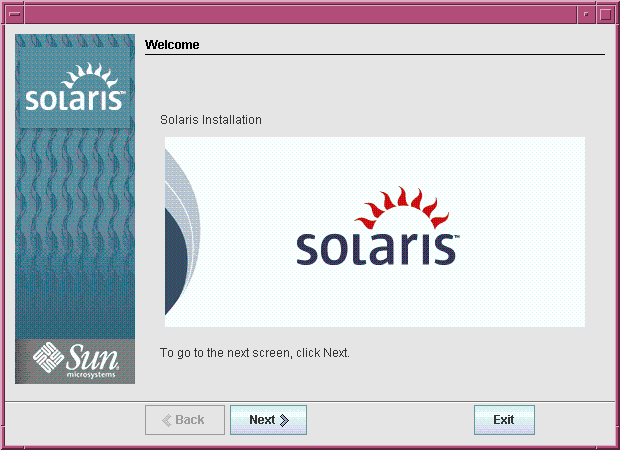
The Installer Questions screen appears.
-
-
Decide if you want to reboot the system automatically and if you want to automatically eject the disc. Click Next.
The Specify Media screen appears.
-
Specify the media you are using to install. Click Next.
The License panel appears.
-
Accept the license agreement to continue the installation. Click Next.
The Solaris installation program then determines if the system can be upgraded. To upgrade, the system must have an existing Solaris root (/) file system. The Solaris installation program detects the necessary conditions and then upgrades the system.
The Select Upgrade or Initial Install screen appears.
-
Decide if you want to perform an initial installation or an upgrade. Click Next.
The next screen enables you to choose a default installation or a custom installation.
-
Select the type of installation you want to perform. Click Next.
-
Select Default Install to install the Entire Solaris Software Group.
-
Select Custom Install if you want to perform the following tasks.
-
Install a specific software group
-
Install additional software
-
Install specific software packages
-
Install a specific locale
-
Customize the disk layout
For more information about software groups, see Disk Space Recommendations for Software Groups.
-
Note –The text installer does not prompt you to select a Default or Custom Installation. To perform a default installation, accept the default values that are provided in the text installer. To perform a custom installation, edit the values in the text installer screens.
-
-
If you are prompted, answer any additional configuration questions.
When you have provided the information that is required to install the system, the Ready to Install screen is displayed.
Figure 2–4 Solaris Installation Ready to Install Screen
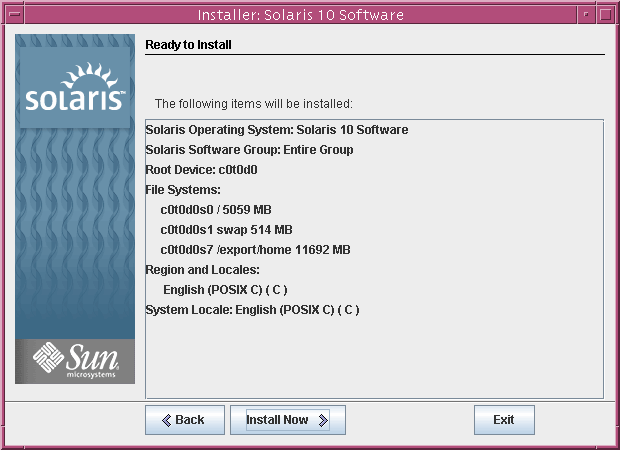
-
Click Install Now to install the Solaris software. Follow the instructions on the screen to install the Solaris software.
When the Solaris installation program finishes installing the Solaris software, the system reboots automatically or prompts you to reboot manually.
If you are installing additional products, you are prompted to insert the DVD or CD for those products. For installation procedures, refer to the appropriate installation documentation.
After the installation is finished, installation logs are saved in a file. You can find the installation logs in the /var/sadm/system/logs and /var/sadm/install/logs directories.
-
If you did not select automatic reboot during the installation, reboot the system.
# reboot
Troubleshooting
If you encountered any problems during the installation or upgrade, see Appendix A, Troubleshooting (Tasks), in Solaris 10 11/06 Installation Guide: Custom JumpStart and Advanced Installations.
- © 2010, Oracle Corporation and/or its affiliates
